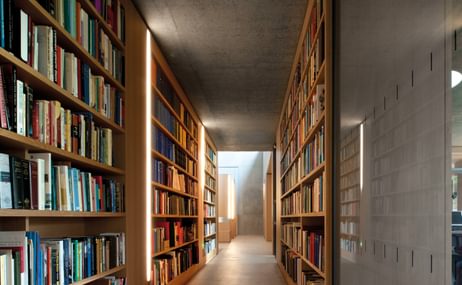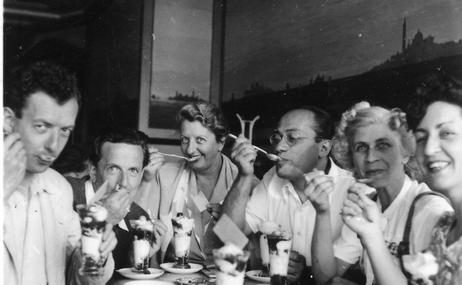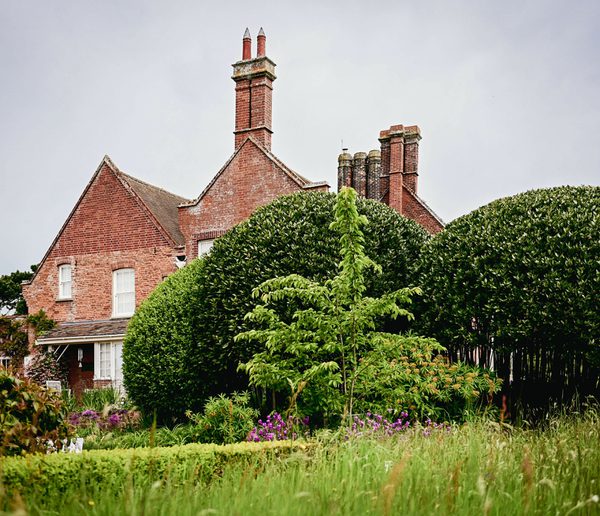Dr Lucy Walker, curator of the current Red House exhibition, Britten & Women, gives an insight into some of the characters she chose to include in the show. And reveals some surprising connections between these fascinating women...
The new exhibition at The Red House is on a relatively unexplored subject: Britten’s close, lifelong relationships with women, and the fascinating female characters in his dramatic works. The composer is generally known for his collaboration with and stories about men – particularly of course his partner Peter Pears, and his many operas focussing on male protagonists. But it was not at all difficult, even during the early stages of researching Britten & Women, to come up with a lengthy and varied list of remarkable women whom Britten knew and worked with. Furthermore, in exploring the lives of a large group of women who lived and worked in the mid-twentieth century there was the opportunity to examine the cultural context of ‘women at work’. Accounts of the twentieth century – and particularly the 1950s – have been undergoing a certain amount of re-evaluation, especially with regard to women’s roles and their working lives. The women in this exhibition had careers, vocations, and a tremendous sense of purpose.
Above image: Britten with his sister, Beth, on her wedding day in 1937. Photographer unknown

Imogen Holst and Elizabeth Maconchy in 1977
Credit: Nigel LuckhurstOne of the great pleasures of curating this exhibition was browsing through the remarkable archival collections held at Britten Pears Arts. Nearly all of the images in the exhibition and in its accompanying guidebook come from the archival holdings, which include both formal and informal photographs, as well as those relating to operatic productions (including both onstage and backstage images). Britten himself appears in almost half of the images, and as a staff member at The Red House remarked after an early viewing of the exhibition, it is striking how comfortable he seems in the photographs as he was more often ill-at-ease in front of the camera. In image after image, he is happily leaning in to his female colleagues and friends, such as Joan Cross and Galina Vishnevskaya. Indeed, there are many other photographs held in the archive of Britten and Vishnevskaya, often affectionately draped around each other. (Britten is, of course, fully at home with two female members of his household in particular: his dachshunds Clytie and Gilda).

Olive Zorian in the 1950s
Credit: Photographer unknown, image courtesy of Isla BaringThe women celebrated in the exhibition fit naturally into groups, although some of them appear in more than one category. (Inevitably, there are some women in Britten’s life who, due to space constraints, are not represented). Each group also has a ‘featured’ woman, the subject of particular focus, and whose life and work is further explored in the exhibition display cases and art exhibits. The groups are: Performers (featured: mezzo-soprano Kathleen Ferrier), Administrators and Assistants (soprano and opera producer Joan Cross), Friends and Family (Marion Thorpe (nee Stein), Composers (Imogen Holst), and Artists and Writers (painter Mary Potter). There is a mini-biography of each woman, and a longer piece about the ‘featured’ woman in each group. The largest groups are, perhaps not surprisingly ‘Performers’ and ‘Friends and Family’ (the latter could easily have featured many from the other groups as well). Some of the ‘Performers’ group appeared in last year’s exhibition ‘Such an Artist to Write For’, which celebrated the artists who inspired Britten’s music. But many others are included here, such as Olive Zorian, leader of an all-female quartet during World War II, and leader of the English Opera Group orchestra until the late 1950s.
The women in this exhibition had careers, vocations, and a tremendous sense of purposeDr Lucy Walker

Britten with Galina Vishnevskaya and her husband Mstislav Rostropovich on holiday in Armenia in 1965
Credit: Photographer unknownThe Friends and Family group includes Britten’s two sisters Beth and Barbara, to whom he was particularly close, as well as his mother Edith and niece Sally Schweizer. Many of Britten’s women friends provided the kind of ‘family’ atmosphere that Britten often craved, such as Beata and Elizabeth Mayer, who Britten and Pears lived with in the USA in the early 1940s, and Marion Thorpe (formerly Harewood, née Stein) who knew Britten from her late teens.
The Administrators and Assistants group ranges from trusted housekeepers, such as Miss Hudson, through to Fidelity Cranbrooke, the first Chair of the Aldeburgh Festival. It is headed by Joan Cross, who not only sang leading roles in many Britten operas but ran Sadlers Wells opera company during its extraordinary war-time tour of the UK. The relatively small group of Artists and Writers features Mary Potter, whose paintings are prominently displayed in The Red House, and for whom Britten built a house in the grounds – Red Studio, which today is one of Britten Pears Arts’ Creative Retreat properties.
Finally, the Composers group – led by Imogen Holst – comprises composers Britten knew when he was at the Royal College of Music, including Grace Williams and Elizabeth Maconchy, as well as Elisabeth Lutyens and South African composer Priaulx Rainier. While these composers are not perhaps as well-known as their male contemporaries, their works are gaining in prominence with many featured in this year’s Aldeburgh Festival. The exhibition also includes a short film in which women composers working today (Lillie Harris, Sarah Angliss and Shiva Feshareki) discuss their own work, as well as the pioneering careers of their forbears.
One further section of the exhibition explores the dramatic roles Britten composed for women in the operas The Rape of Lucretia, The Turn of the Screw and Gloriana as well as his late cantata Phaedra. Performers and directors who are closely associated with these works discuss Britten’s roles for women in the accompanying short film (including contributions from Fiona Shaw, Dame Sarah Connolly, Blythe Gaissert, Christine Brewer, and Louisa Muller).
The women whom Britten knew and worked with were not simply ‘handmaidens’ to his geniusDr Lucy Walker

Joyce Grenfell at Snape Maltings, 1977
Credit: Nigel LuckhurstAs the exhibition amply demonstrates, the women whom Britten knew and worked with were not simply ‘handmaidens’ to his genius. Indeed, the composer himself takes a back seat. Partly as a result, the collaborations and relationships between the women became one further avenue of exploration. Some of these are reflected in pictures, such as the photograph of composers Imogen Holst and Elizabeth Maconchy and of artist Milein Cosman sketching Joan Cross. But other connections are drawn out, such as Margery Spring-Rice and Fidelity Cranbrook’s work on the Suffolk Rural Music Schools Project; Kathleen Ferrier and Nancy Evans’ friendly rivalry during the first run of The Rape of Lucretia, Viola Tunnard’s performing partnership with Joyce Grenfell (and her playing for Lesley Duff during World War II), and Hedli Anderson inspiring a song-cycle from Elisabeth Lutyens. Pioneering conductor Iris Lemare, furthermore, worked with Anne Mcnaghten (of whom no photograph was traceable, unfortunately) and Lutyens on a significant concert series in the 1930s, premiering the works of many contemporary composers, including Britten, but also featuring, Maconchy and Grace Williams. This exhibition is, effectively, a group biography: illuminating an aspect of Britten’s story that has always been there, but never before fully told.
Britten and Women is at the Red House, every Thursday to Sunday from 30 March – 29 October. Book your tickets here.
Read next

Archive Treasures: The story of a Holocaust survivor and a musical legacy
We mark the 80th anniversary of the end of World War II, and of the liberation of the death camps with the story of a special…
Archive Treasures: Armenian Amphora
Among the many treasures on display at the Red House is the splendid Armenian amphora. It dates from the Urartu era, a civilization which, from the…
Archive Treasures: The English Opera Group
The English Opera Group collection forms part of the Britten Pears Arts Archive which documents the lives and work of Britten and Pears, as well as…

